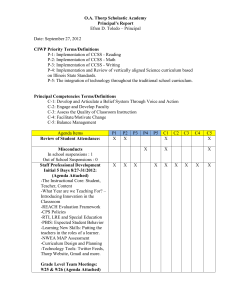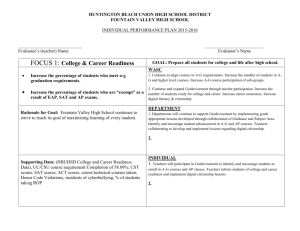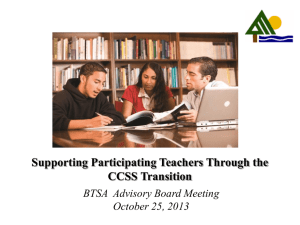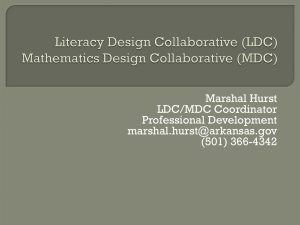Tactical Questions: What are the three different types of math
advertisement
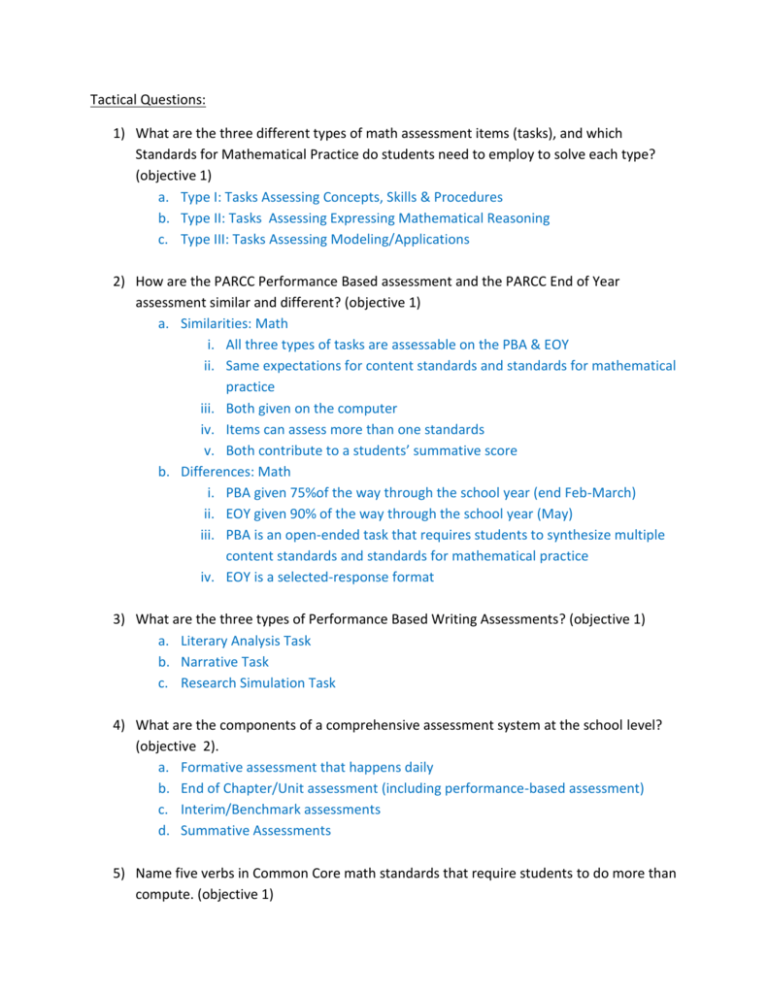
Tactical Questions: 1) What are the three different types of math assessment items (tasks), and which Standards for Mathematical Practice do students need to employ to solve each type? (objective 1) a. Type I: Tasks Assessing Concepts, Skills & Procedures b. Type II: Tasks Assessing Expressing Mathematical Reasoning c. Type III: Tasks Assessing Modeling/Applications 2) How are the PARCC Performance Based assessment and the PARCC End of Year assessment similar and different? (objective 1) a. Similarities: Math i. All three types of tasks are assessable on the PBA & EOY ii. Same expectations for content standards and standards for mathematical practice iii. Both given on the computer iv. Items can assess more than one standards v. Both contribute to a students’ summative score b. Differences: Math i. PBA given 75%of the way through the school year (end Feb-March) ii. EOY given 90% of the way through the school year (May) iii. PBA is an open-ended task that requires students to synthesize multiple content standards and standards for mathematical practice iv. EOY is a selected-response format 3) What are the three types of Performance Based Writing Assessments? (objective 1) a. Literary Analysis Task b. Narrative Task c. Research Simulation Task 4) What are the components of a comprehensive assessment system at the school level? (objective 2). a. Formative assessment that happens daily b. End of Chapter/Unit assessment (including performance-based assessment) c. Interim/Benchmark assessments d. Summative Assessments 5) Name five verbs in Common Core math standards that require students to do more than compute. (objective 1) Interpret, draw, create, explain, understand, express 6) What purpose does the Individual Learning Plan (ILP) serve as part of an Advisory (direct SEL instruction) program plan? 7) In what ways do restorative responses to discipline serve to prevent incidents and improve school culture? 8) Name four (4) restorative responses that can be employed as a first response when addressing a discipline infraction. 9) Identify three best practices in to implement in-class, out of class, or consultation resource services. (Objective 3) a. b. c. d. e. Co-teaching models Consultative model Collaborative planning Effective scheduling Shared responsibilities/ownership 10) How do you utilize Universal Design for Learning to provide access to the ageappropriate general education curriculum for students with disabilities? (Objective 4) a. Instructional technology i. Text-to-Speech ii. Speech-to-Text b. Instructional strategies i. Multiple means of representation ii. Multiple means of expression iii. Multiple means of engagement c. Assistive Technology i. Communication tools ii. Adapted equipment 11) List the components of the literacy block (Objective 3) a. Whole group-Core Curriculum (eg: Expeditionary Learning) b. Small group-Teacher led direct instruction based upon students’ needs. c. Work stations-(language, vocabulary, independent reading) 12) 13) How do the multiple choice items on the LAL NJ ASK differ from the evidence based selected-response and the technology enhanced constructed response items on the PARCC ELA assessments? (objective 1). Application Questions: 14) How do the writing demands of PARCC differ from those expected on the NJ Ask? (objective 1) 15) What is the difference between the Common Core Standards and a curricular resource (Math in Focus, Go Math, Expeditionary Learning)? (Objective 3) 16) Based upon the five verbs you listed from the Common Core math standards (question 6) what are the implications for teaching and for student learning? (objectives 3,4,5) 14) The role of the SST is: a. to address concerns of students who present with only behavioral issues b. to utilize an integrative approach to provide structured academic, health, attendance and behavioral supports to promote student success c. to meet on a consistent basis for the purpose of engaging collaboration, data analysis, intervention development and progress monitoring d. b & c 15) As a principal leader, identify and discuss three (3) effective strategies to implement advisory within your school day. 16) How can administrators ensure that supports contained in the IEPs are provided for students with disabilities? (Objective 4) a. Observe classroom periodically to see that adaptations and supports are being implemented b. Obtain appropriate curriculum materials for students with disabilities c. Review documentation kept by teaching staff on the use and effectiveness of IEP supports; and d. Meet with teachers (on an ongoing basis) to discuss student progress regarding IEP goals and objectives 17) How should general education teachers and special education teachers share responsibility for implementing IEPs? (Objective 5) a. Both teachers assist in the creation, implementation, and documentation of academic and behavioral interventions i. Provide input on student’s present level, goals, accommodations, modifications, ii. Actively participate in evaluations and IEP meetings (imperative that the general ed teacher provide input on the selection, locations, subject areas, and frequency of the accommodations and modifications used in general education setting) b. Both teachers implement accommodations, modifications, and supplementary services as indicated on each student’s IEP c. If needed, revise/amend IEP based on observations and student’s progress Self-Reflection 18) There is shared understanding of CCSS-aligned instruction across the teaching faculty in our school. (objectives 2, 4) a. CCSS content standards are largely seen as separate and distinct from instructional practices. b. Teachers have been exposed to the CCSS instructional shifts, but there is not a clear and shared understanding among teachers regarding how instruction should change to meet CCSS expectations. c. Teachers have studied the standards, the majority can identify and explain the instructional shifts, and some teachers have made shifts in their instruction. d. Instruction in all classrooms incorporates the instructional shifts and other strategies to engage students in learning that is aligned to the CCSS. 19) Instructional coaching in our school helps teachers learn and apply the CCSS to instruction. (objectives 4 &5) a. There is not adequate coaching or access to expertise on improving instruction in our school. b. Instructional coaching, when it is provided is infrequently connected with CCSS. c. Instructional coaching helps teachers connect the CCSS to everyday instruction, but expertise is largely outside the school and not always available when needed. d. Expertise in applying the CCSS to instruction has been built among teacher leaders in our school, and all teachers have regular opportunities to receive CCSS-aligned instructional coaching from expert colleagues. 20) Teachers regularly apply the CCSS as they plan and teach. (Objectives 3, 4, 5) a. Many teachers don’t know how to apply the CCSS to their teaching. b. Most teachers have seen exemplars (e.g. videos and descriptions) of CCSS-aligned instruction but aren’t confident integrating the CSS into their own practice. c. Teachers in English language arts have made significant shifts in instruction to enact CCSS, but teaching in other subjects has not changed significantly. d. Teachers across the curriculum regularly apply CCSS expectations to their planning and instruction. 21) Our school implements a comprehensive assessment system across all core subject areas that includes interim/benchmark and summative assessments as well as data for formative purposes (e.g. ongoing collection and analysis of student work aligned to the CCSS). (Objectives 2,5) a. Our school has not defined a comprehensive assessment system. b. Our school has defined an assessment system, but is not comprehensive (eg: it does not include adequate formative elements) and/or is not aligned across all subject areas. c. Our school has a comprehensive assessment system, but it is not implemented with fidelity or the connection to ongoing analysis of student work is unclear. d. Our school has a comprehensive assessment system aligned to the CCSS across all core subject areas, and it is implemented with fidelity, including drawing specific connections between data from the assessment system and data from ongoing student work. 22) Teachers in our school analyze assessment results in order to determine students’ needs in relation to the CCSS. Instructional staff systematically and frequently analyses student work to identify strengths and gaps in the instructional program. (Objective 2, 5) a. Teachers do not receive training or time to analyze assessment results in order to determine students’’ needs in relation to the CCSS. b. Teachers have time to analyze student assessment data but do not receive support in how to facilitate those discussions or how to connect assessment results to formative data, including those generated through looking at student work. c. Teacher receive training and have time to analyze assessment results and to look at formative data including student work, but the outcome of the time and planning often does not improve instruction. d. Teachers receive training and planning time to analyze student assessment data and formative data including student work, and these experiences, regularly improve instruction. 23) Our leadership team establishes and supports common implementation expectations for CCSS-aligned instructional practices (eg: use of text-dependent questions, active student discussion, constructing arguments orally and in writing) across the teaching faculty. (Objectives 2,4,5) a. CCSS implementation expectations are unclear to most teachers. b. Teachers in ELA are beginning to implement a few, common instructional practices established by the leadership team. c. Most teachers are beginning to implement common instructional practices established by the leadership team. d. Instruction in all classrooms is deeply focused on CCSS-aligned practices across disciplines. 24) There is a shared understanding of the role of the Student Support Team (SST) among all staff in our school: a. A few staff are aware of the team name change from I&RS, but still lack clarity on the role of the SST b. Most staff have at least a partial understanding that the SST serves as a body to seek intervention support for students having difficulty with academic, behavior or health matters. c. All staff were provided with in-service training where the role of the SST was defined as both a pro-active SEL planning unit and responsive intervention team d. All staff were provided with in-service training on the role of the SST, and every teacher served at least once during the year on a rotational basis as an SST member. 25) Based upon your responses, what skills and knowledge do you hope to acquire over the next 8 days?
